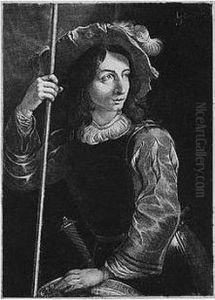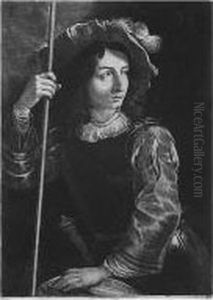Prince Rupert Of The Rhine Paintings
Prince Rupert of the Rhine was a notable figure in the 17th century, not only for his military role during the English Civil War but also for his contributions to the arts, particularly in the field of printmaking. Born on December 17, 1619, in Prague, he was the third son of Frederick V, Elector Palatine, and Elizabeth Stuart, the daughter of James I of England. His life was marked by the tumult of European wars, the struggle for power, and his enduring interest in science and art.
In his early years, Rupert was caught in the upheavals of the Thirty Years' War, which shaped his future as a soldier. By the time of the English Civil War (1642–1651), he had become a prominent Royalist commander, known for his daring tactics and swift cavalry charges. Despite his military commitments, Rupert developed a deep interest in the arts and sciences. He was particularly fascinated by the emerging field of printmaking and is credited with inventing the mezzotint technique, a revolutionary method of engraving that allowed for the creation of prints with subtle gradations of tone. This innovation greatly contributed to the art of printmaking, influencing the production of images well into the future.
Beyond his military and artistic endeavors, Prince Rupert was known for his patronage of scientists and artists. He was a founding member of the Royal Society, England's premier scientific institution, reflecting his broad interests and intellectual curiosity. His life after the Restoration in 1660 saw him taking on various roles, including serving as the Duke of Cumberland, a naval commander, and as a member of the King's council. Despite the political and military upheavals that characterized much of his life, Rupert's contributions to art and science remained a significant part of his legacy.
Prince Rupert of the Rhine died on November 29, 1682. His life was a remarkable blend of action and intellect, embodying the spirit of a Renaissance man long after the Renaissance itself had ended. His impact on printmaking, combined with his military service and support for the scientific community, marks him as a unique figure in the annals of history, bridging the worlds of art, science, and politics in a time of great change.

